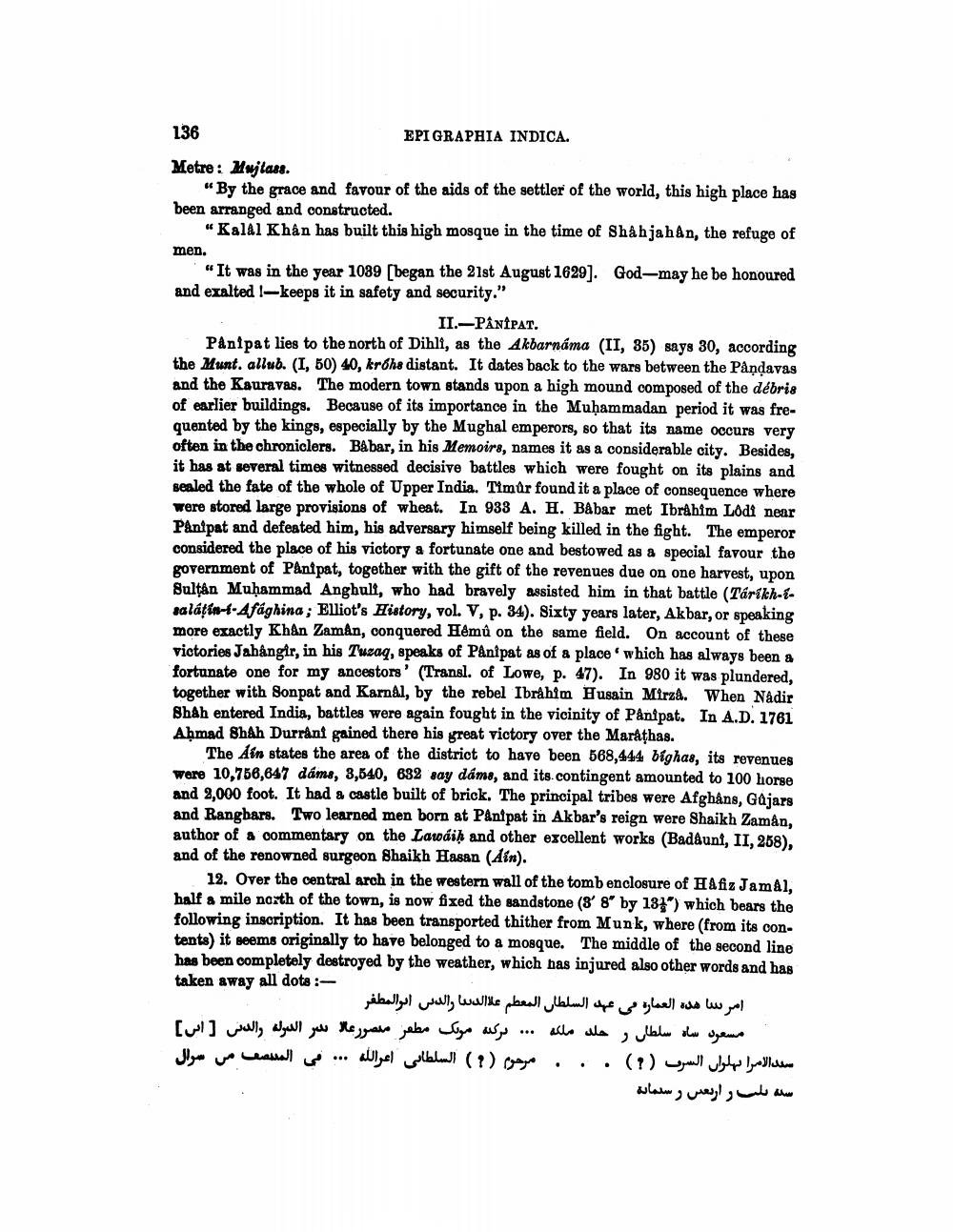________________
136
EPIGRAPHIA INDICA. Metre: Mujtass.
"By the grace and favour of the aids of the settler of the world, this high place has been arranged and constructed.
"Kalal Khan has built this high mosque in the time of Shahjahan, the refuge of men.
"It was in the year 1089 [began the 21st August 1629]. God-may he be honoured and exalted 1-keeps it in safety and security."
II.-PANIPAT. Panipat lies to the north of Dihli, as the Akbarnáma (II, 35) says 30, according the Munt. allub. (1, 50) 40, krőhe distant. It dates back to the wars between the Pandavas and the Kauravas. The modern town stands upon a high mound composed of the débris of earlier buildings. Because of its importance in the Muhammadan period it was frequented by the kings, especially by the Mughal emperors, so that its name occurs very often in the chroniclers. BAbar, in his Memoirs, names it as a considerable city. Besides, it has at several times witnessed decisive battles which were fought on its plains and sealed the fate of the whole of Upper India. Timur found it a place of consequence where were stored large provisions of wheat. In 933 A. H. Båbar met Ibrahim Lodi near Panipat and defeated him, his adversary himself being killed in the fight. The emperor considered the place of his victory a fortunate one and bestowed as a special favour the government of Panipat, together with the gift of the revenues due on one harvest, upon Sultan Muhammad Anghult, who had bravely assisted him in that battle (Tarikh-Esalátin-f-4fághina; Elliot's History, vol. V, p. 34). Sixty years later, Akbar, or speaking more exactly Khan Zaman, conquered Hemû on the same field. On account of these victories Jahangir, in his Tuzaq, speaks of Pånipat as of a place which has always been a fortunate one for my ancestors' (Transl. of Lowe, p. 47). In 980 it was plundered. together with Sonpat and Karnal, by the rebel Ibrahim Husain Mirz. When Nadir Bhah entered India, battles were again fought in the vicinity of Panfpat. In A.D. 1761 Ahmad Shah Durrant gained there his great victory over the Marathas.
The Ain states the area of the district to have been 568,444 bighas, its revenues were 10,766,647 dáms, 3,540, 882 say dáms, and its contingent amounted to 100 horse and 2.000 foot. It had a castle built of brick. The principal tribes were Afghans, Gujars and Rangbars. Two learned men born at Panipat in Akbar's reign were Shaikh Zaman, author of a commentary on the Lawih and other excellent works (Badauni, II, 258), and of the renowned surgeon Shaikh Hasan (Ain).
12. Over the central arch in the western wall of the tomb enclosure of Hafiz Jamal, half a mile north of the town, is now fixed the sandstone (8' 8' by 131") which bears the following inscription. It has been transported thither from Munk, where (from its contents) it seems originally to have belonged to a mosque. The middle of the second line has been completely destroyed by the weather, which has injured also other words and has taken away all dots :
ابوالمطفر امرسا هده العمارة في عهد السلطان المعطم علاالدیا والد
مطهر مصررعد سر السرله والد مسعود ساه سلطان رحلد ملکه ... درکه مریک
[ ای ]
Ilyen who wewall we .. all yel Wilblondi (+) con .
.
.
(?)
zwall ulstens Iyoylece
و سرمایه
سده بلب ر اربع




